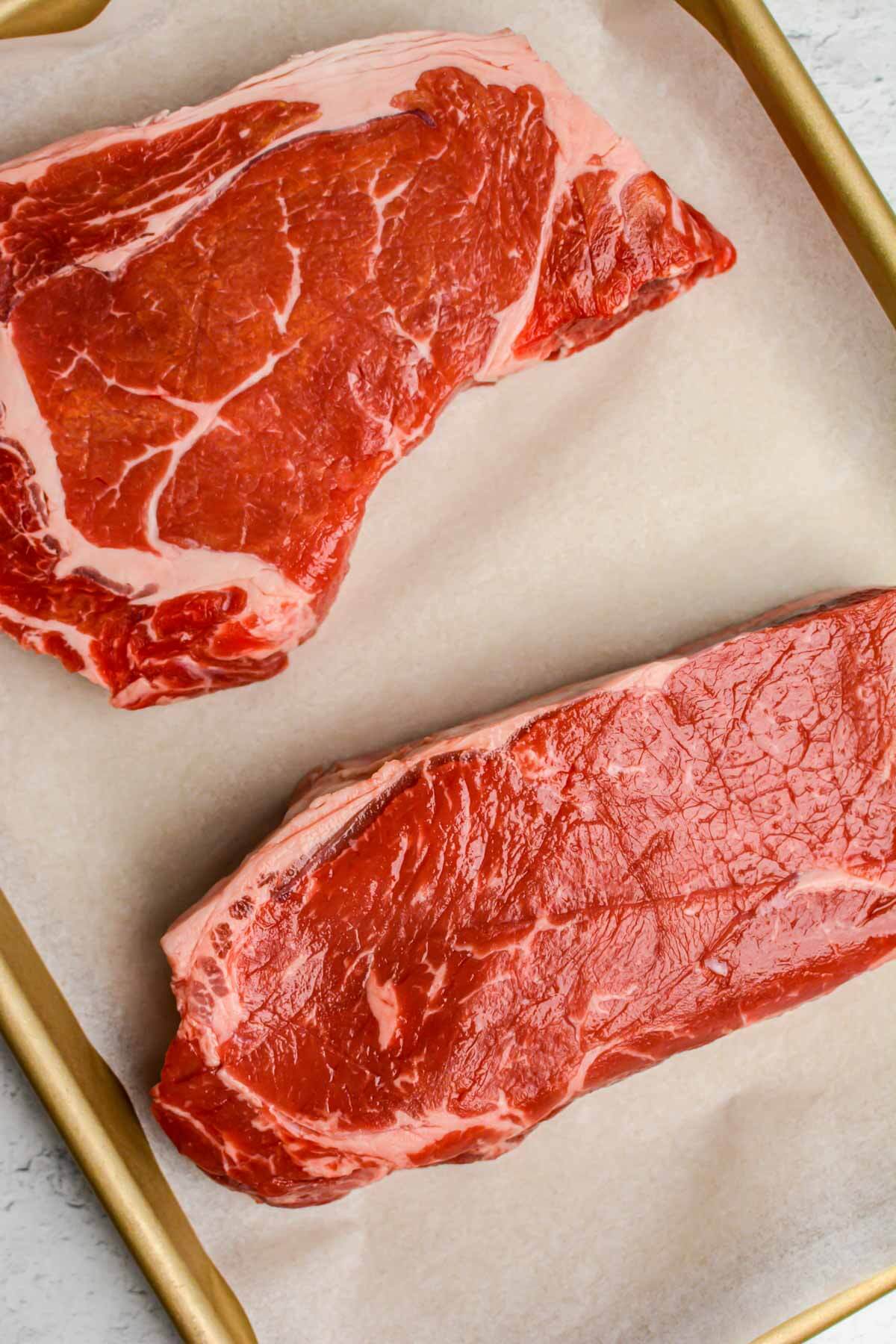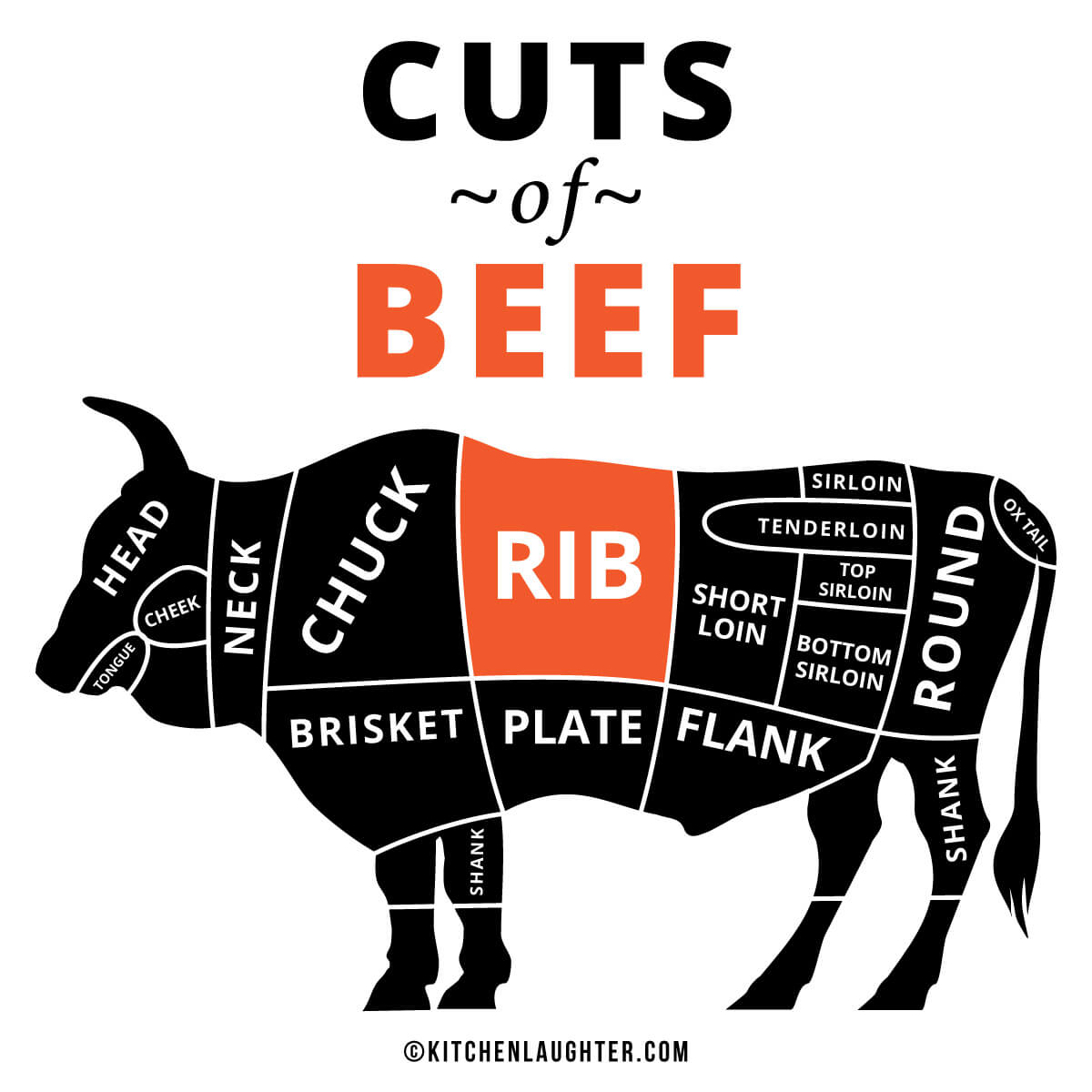Sitting down to a high-quality and perfectly cooked steak is like Christmas, no matter what the time of year. But, when you go to purchase steak for the grill, how do you choose the best cut? Let’s talk about the differences between New York Strip vs Ribeye, arguably two of the best steaks available in the market.

What is New York Strip?

This beautiful cut of beef is cut from the short loin of the cow. With almost 100% muscle taken from behind the rib right in front of the rear leg, the New York strip has amazing flavor and tenderness.

This particular muscle is not used very much, so the meat does not get tough or chewy. Because it does not have as much fat, it can dry out or overcook more easily than ribeye.
It comes from one half of the porterhouse, if you’re looking for a hearty cut of meat to cook!
What is Ribeye?

Ribeye steaks are cut from the very best part of the prime rib (mostly from the longissimus dorsal muscle), and each ribeye comes from between the ribs.

It can be sold bone-in or boneless cut of meat and is very tender and flavorful. Many people consider the ribeye to be the best steak available.
Butchers will often label a ribeye as a delmonico steak, which is confusing for buyers. A true delmonico is a signature boneless steak coming from the short loin but you will be served a ribeye at the famous Delmonico Manhattan restaurant.
🥩 Attributes
| Ribeye | New York Strip | |
|---|---|---|
| Cost | +$1-2/lb (more expensive) | -$1-2/lb (less expensive) |
| Texture | The most tender. Buttery soft. | Very tender. Slightly chewier than ribeye. |
| Marbling | More marbling throughout than the NY Strip. | A high amount of marbling. A strip of fat on one side |
| Tasting | Rich and Deep. The best flavor. | Excellent flavor. |
| Thickness | >1″ thickness minimum | 1-1½” Thick |
| Cut | Fatty. From the rib. | Lean. There is less fat from the short loin right in front of the rear leg. |
| Size | Round or oval steak, as much as 16 ounces. | Long Thin Rectangle, usually between 8-10 ounces. |
| Cooking Method | Grill, Pan-Fry, Reverse Sear, Sous Vide, broil, or air fry. | Grill, Pan-Fry, Reverse Sear, Sous Vide, broil, or air fry. |
| Other Names | Rib Steak, Beauty Steak, Delmonico Steak, Scotch Fillet, Cowboy Cut (bone-in) or Spencer Steak | Ambassador Steak, Omaha Steak, Kansas City Steak, Top Loin Steak, Shell Steak, Country Club Steak, or Hotel-Style Steak |
❓ How to Choose
The good news is that these two types of steak are very similar and both are very high quality. You cannot go wrong here. If you prefer the most beautiful, intense flavor and tenderness possible, go with ribeye. This is because of the higher amount of marbling. That’s not to say the New York strip is bad — it’s a great steak. Ribeye just has a slight edge on the quality of flavor and texture.
If you prefer leaner meat with plenty of beefy flavor or want to go with the less expensive option, get NY Strip Steaks. Both respond well to similar cooking methods, have great flavor, reheat well for leftovers, and will definitely impress your guests.
If you still aren’t sure, find the local butcher shops and ask them for advice.
🔥 How to Grill
Both of these cuts of steak will be perfect when cooked medium-rare to medium. A grill at high heat with a quick sear and short cooking time is ideal. First, set your steaks out so they come up to room temperature. Clean and preheat your grill to near the hottest setting.
Next, season the steaks on both sides. I am a bit of a traditionalist and really prefer a simple salt and pepper mix, but it is a personal preference. Place the seasoned steaks on your hot grill. When they have a good exterior sear, flip to sear the other side. This should only take about four minutes per side in total for a medium-rare steak. Use a meat thermometer to check for an internal temperature of 130° – 140°F.
Because ribeye has a higher fat content and you want that fat to render, grilling ribeye can be tricky. Some like to use a two-zone method for ribeye. A high-heat zone allows for a fast sear on both sides of the meat. The meat is then moved to lower heat to finish cooking. This avoids flare-ups from dripping fat and allows the fat to fully render, improving the flavor of the steak.
When family members enjoy a medium to medium well steak, try the Reverse Sear method where the grill is at a lower heat at first and then you turn it up to a blazing hot temp to sear the outside to develop that crust. This is accomplished by setting up for two-zone grilling. One side is direct heat and the other side is indirect.

🍽️ How to Serve
Let the steak rest for a few minutes once you remove it from the heat. It takes about 10 minutes for the juices to set up. If you cut into them earlier, the juices can run out. Freshly cooked juicy steak pairs very well with a bright salad, potatoes, homemade bread, and roasted vegetables. Pull out your favorite BBQ Sides and your cookout will be a huge success.
How to Store Leftover Steak
Place your leftover ribeye or New York strip in an airtight container and keep it in the refrigerator for two or three days. Cut it up and reheat it in a skillet on the stovetop to serve with scrambled eggs or in a stir fry. You can also reheat the whole steak on a grill, in the oven, or even in the microwave.
Leftovers can be frozen as well. It will keep for two or three months in an airtight container. I like to wrap it in saran first and then put it in a container. It minimizes the chances that the steak will get freezer burn.
How Many Calories in Ribeye Steak?
The USDA reports that a four ounce ribeye has 272 calories. Note that the American Heart Association recommends that you limit the serving portion to three ounces.
Recipe FAQ
Ribeye has more fat marbling and is, therefore, more tender than New York Strip. They are both very tender cuts of meat, however, so you cannot go wrong.
New York Strip is usually $1-2 cheaper per pound than ribeye. Depending on where you live, NY Strip will be $10-16 per pound, and Ribeye will be $12-19 per pound.
The main difference between New York Strip and Ribeye is the amount of marbling and the resulting intensity of flavor. Ribeye wins by a slim margin on both of these counts.
It is cut from the rib section, from the prime rib roast, usually cut from the 6-12th rib section, and must be boneless to be truly classified as ribeye steaks.
This steak is cut from the short loin of the cow directly in front of the rear leg, behind the ribs, and is boneless.
More Recipes

Jason’s been firing up the grill for over 30 years after graduating from the US Coast Guard Academy. His love of finely-grilled steak and chicken led him to buy his first Weber grill to put on his apartment patio in 1992. Each military move led to a new grill (a mixture of gas and charcoal) until he fell in love with the Big Green Egg in 2008. Since then, he has added another 4 grills to the collection. Yes, he has a problem. Jason loves smoking in the ceramic BGE with exotic woods including olive wood from Egypt and hard to find varieties such as sassafras and orange wood. Jason takes the term “foodie” to a whole new level, jumping at the chance to take food tours and cooking classes during foreign travels. These have provided inspiration to incorporate new ideas into recipes when he gets back home. He has been featured in Fox News, Parade, Yahoo News, Kansas City Living and more. After retiring from the military and moving to southwest Florida, he has focused grilling and smoking locally sourced meats and fish (read: he likes to catch his own fish!)








Leave a Reply